Control Effect of Deposition Processes on Shale Lithofacies and Reservoirs Characteristics in the Eocene Shahejie Formation (Es4s), Dongying Depression, China
Abstract
1. Introduction
2. Geological Setting
3. Materials and Methods
4. Results
4.1. Mineral Composition
4.2. Lithofacies
4.2.1. Middle-High Organic Laminated Calcareous Fine-Grained Sedimentary Rocks (LF1)
4.2.2. Middle-High Organic Laminated Mixed Fine-Grained Sedimentary Rocks (LF2)
4.2.3. Middle-High Organic Flaggy Mixed Fine-Grained Sedimentary Rocks (LF3)
4.2.4. Middle-High Organic Flaggy Calcareous Fine-Grained Sedimentary Rocks (LF4)
4.2.5. Middle-High Organic Massive Calcareous Fine-Grained Sedimentary Rocks (LF5)
4.2.6. Middle Organic Massive Mixed Fine-Grained Sedimentary Rocks (LF6)
4.2.7. Low Organic Massive Argillaceous Fine-Grained Sedimentary Rocks (LF7)
4.2.8. Low Organic Massive Felsic Fine-Grained Sedimentary Rocks (LF8)
4.2.9. Low Organic Massive Mixed Fine-Grained Sedimentary Rocks (LF9)
4.3. Organic Matter Characteristics
4.4. Reservoir Characteristics
4.4.1. Pore Types
- Interparticle pores.
- 2.
- Intraparticle pores.
- 3.
- Lamina fissures.
- 4.
- Fractures.
4.4.2. Pore Size Distribution and Pore Structures Characteristics
5. Discussion
5.1. Deposition Processes and Deposition Model
5.2. Pore Structures
5.3. Controlling Effect of Deposition Processes on Lithofacies and Reservoir Characteristics
6. Conclusions
Author Contributions
Funding
Data Availability Statement
Acknowledgments
Conflicts of Interest
References
- Slatt, R.M.; O’Brien, N.R. Pore types in the Barnett and Woodford gas shales: Contribution to understanding gas storage and migration pathways in fine-grained rocks. AAPG Bull. 2011, 95, 2017–2030. [Google Scholar] [CrossRef]
- Jarvie, D.M. Shale resource systems for oil and gas: Part 2—Shale-oil resource systems. In Shale Reservoirs—Giant Resources for the 21st Century: AAPG Memoir; Breyer, J.A., Ed.; Worldwide Geochemistry, LLC: Humble, TX, USA, 2012; Volume 97, pp. 89–119. [Google Scholar]
- Liang, C.; Wu, J.; Cao, Y.; Liu, K.; Khan, D. Storage space development and hydrocarbon occurrence model controlled by lithofacies in the Eocene Jiyang Sub-basin, East China: Significance for shale oil reservoir formation. J. Pet. Sci. Eng. 2022, 215, 110631. [Google Scholar] [CrossRef]
- Loucks, R.G.; Ruppel, S.C. Mississippian Barnett Shale: Lithofacies and depositional setting of a deep-water shale-gas succession in the Fort Worth Basin, Texas. AAPG Bull. 2007, 91, 579–601. [Google Scholar] [CrossRef]
- Jarvie, D.M.; Hill, R.J.; Ruble, T.E.; Pollastro, R.M. Unconventional shale-gas systems: The Mississippian Barnett Shale of north-central Texas as one model for thermogenic shale-gas assessment. AAPG Bull. 2007, 91, 475–499. [Google Scholar] [CrossRef]
- Aplin, A.C.; Macquaker, J.H.S. Mudstone diversity: Origin and implications for source, seal, and reservoir properties in petroleum systems. AAPG Bull. 2011, 95, 2031–2059. [Google Scholar] [CrossRef]
- Schieber, J. Shale microfabrics and pore development: An overview with emphasis on the importance of depositional processes. In Gas Shale of the Horn River Basin; Canadian Society of Petroleum Geologists: Calgary, AB, Canada, 2011; pp. 115–119. [Google Scholar]
- Zou, C.; Yang, Z.; Cui, J.; Zhu, R.; Hou, L.; Tao, S.; Yuan, X.; Wu, S.; Lin, S.; Wang, L.; et al. Formation mechanism, geological characteristics and development strategy of nonmarine shale oil in China. Pet. Explor. Dev. 2013, 40, 15–27. [Google Scholar] [CrossRef]
- Liang, C.; Wu, J.; Jiang, Z.; Cao, Y.; Song, G. Sedimentary environmental controls on petrology and organic matter accumulation in the upper fourth member of the Shahejie Formation (Paleogene, Dongying Depression, Bohai Bay Basin, China). Int. J. Coal Geol. 2018, 186, 1–13. [Google Scholar] [CrossRef]
- Li, Q.; You, X.; Jiang, Z.; Wu, S.; Zhang, R. Lithofacies and reservoir characterization of a source-controlled carbonate succession in a lacustrine rift basin, the Shulu Sag of Bohai Bay Basin, East China. J. Pet. Sci. Eng. 2020, 192, 107180. [Google Scholar] [CrossRef]
- Hemmesch, N.T.; Harris, N.B.; Mnich, C.A.; Selby, D. A sequence-stratigraphic framework for the Upper Devonian Woodford Shale, Permian Basin, west Texas. AAPG Bull. 2014, 98, 23–47. [Google Scholar] [CrossRef]
- Liang, C.; Jiang, Z.; Yang, Y.; Wei, X. Shale lithofacies and reservoir space of the Wufeng–Longmaxi Formation, Sichuan Basin, China. Pet. Explor. Dev. 2012, 39, 736–743. [Google Scholar] [CrossRef]
- Pan, S.; Zou, C.; Yang, Z.; Dong, D.; Wang, Y.; Wang, S.; Wu, S.; Huang, J.; Liu, Q.; Wang, D.; et al. Methods for shale gas play assessment: A comparison between Silurian Longmaxi shale and Mississippian Barnett shale. J. Earth Sci. 2015, 26, 285–294. [Google Scholar] [CrossRef]
- Li, Y.; Wang, X.; Wu, B.; Li, G.; Wang, D. Sedimentary facies of marine shale gas formations in Southern China: The Lower Silurian Longmaxi Formation in the southern Sichuan Basin. J. Earth Sci. 2016, 27, 807–822. [Google Scholar] [CrossRef]
- Liang, C.; Jiang, Z.; Cao, Y.; Zhang, J.; Guo, L. Sedimentary characteristics and paleoenvironment of shale in the Wufeng-Longmaxi Formation, North Guizhou Province, and its shale gas potential. J. Earth Sci. 2017, 28, 1020–1031. [Google Scholar] [CrossRef]
- Jiang, Z.; Liang, C.; Wu, J.; Zhang, J.; Zhang, W.; Wang, Y.; Liu, H.; Chen, X. Several issues in sedimentological studies on hydrocarbon-bearing fine-grained sedimentary rocks. Acta Pet. Sin. 2013, 34, 1031–1039, (In Chinese with English Abstract). [Google Scholar]
- Burton, D.; Woolf, K.; Sullivan, B. Lacustrine depositional environments in the Green River Formation, Uinta Basin: Expression in outcrop and wireline logs. AAPG Bull. 2014, 98, 1699–1715. [Google Scholar] [CrossRef]
- Lazar, O.R.; Bohacs, K.M.; Macquaker, J.H.S.; Schieber, J.; Demko, T.M. Capturing key attributes of fine-grained sedimentary rocks in outcrops, cores, and thin sections: Nomenclature and description guidelines. J. Sediment. Res. 2015, 85, 230–246. [Google Scholar] [CrossRef]
- Wang, Y.; Liang, C.; Sun, X. Shale oil reservoir characteristics and enrichment in the Jiyang Depression, Bohai Bay Basin, East China. J. Earth Sci. 2017, 28, 977–986. [Google Scholar] [CrossRef]
- Wang, M.; Guo, Z.; Jiao, C.; Lu, S.; Li, J.; Xue, H.; Li, J.; Li, J.; Chen, G. Exploration progress and geochemical features of lacustrine shale oils in China. J. Pet. Sci. Eng. 2019, 178, 975–986. [Google Scholar] [CrossRef]
- Jiang, Z.; Kong, X.; Yang, Y.; Zhang, J.; Zhang, Y.; Wang, L.; Yuan, X. Multi-source genesis of continental carbonate-rich fine-grained sedimentary rocks and hydrocarbon sweet spots. Pet. Explor. Dev. 2021, 48, 30–42. [Google Scholar] [CrossRef]
- Li, Q.; Wu, S.; Xia, D.; You, X.; Zhang, H.; Lu, H. Major and trace element geochemistry of the lacustrine organic-rich shales from the Upper Triassic Chang 7 Member in the southwestern Ordos Basin, China: Implications for paleoenvironment and organic matter accumulation. Mar. Pet. Geol. 2020, 111, 852–867. [Google Scholar] [CrossRef]
- Huang, C.; Zhang, J.; Wang, H.; Jiang, S. Lacustrine shale deposition and variable tectonic accommodation in the rift basins of the Bohai Bay Basin in Eastern China. J. Earth Sci. 2015, 26, 700–711. [Google Scholar] [CrossRef]
- Kong, X. Sedimentary Characteristics, Origin and Hydrocarbon Accumulation of Lacustrine Carbonate-Bearing Fine-Grained Sedimentary Rocks; China University of Geosciences (Beijing): Beijing, China, 2020. [Google Scholar]
- Ma, Y.; Fan, M.; Lu, Y.; Liu, H.; Hao, Y.; Xie, Z.; Liu, Z.; Li, P.; Du, X.; Hu, H. Climate-driven paleolimnological change controls lacustrine mudstone depositional process and organic matter accumulation: Constraints from lithofacies and geochemical studies. Int. J. Coal Geol. 2016, 167, 103–118. [Google Scholar] [CrossRef]
- Liu, B.; Bechtel, A.; Gross, D.; Fu, X.; Li, X.; Sachsenhofer, R.F. Middle Permian environmental changes and shale oil potential evidenced by high-resolution organic petrology, geochemistry and mineral composition of the sediments in the Santanghu Basin, Northwest China. Int. J. Coal Geol. 2018, 185, 119–137. [Google Scholar] [CrossRef]
- Macquaker, J.H.S.; Bohacs, K.M. On the accumulation of mud. Science 2007, 318, 1734–1735. [Google Scholar] [CrossRef]
- Plint, A.G. Mud dispersal across a Cretaceous prodelta: Storm-generated, wave-enhanced sediment gravity flows inferred from mudstone microtexture and microfacies. Sedimentology 2014, 61, 609–647. [Google Scholar] [CrossRef]
- Liang, C.; Jiang, Z.; Cao, Y.; Wu, J.; Wang, Y.; Hao, F. Sedimentary characteristics and origin of lacustrine organic-rich shales in the salinized Eocene Dongying Depression. GSA Bull. 2018, 130, 154–174. [Google Scholar] [CrossRef]
- Xie, X.; Li, M.; Littke, R.; Huang, Z.; Ma, X.; Jiang, Q.; Snowdon, L.R. Petrographic and geochemical characterization of microfacies in a lacustrine shale oil system in the Dongying Sag, Jiyang Depression, Bohai Bay Basin, Eastern China. Int. J. Coal Geol. 2016, 165, 49–63. [Google Scholar] [CrossRef]
- Zhang, L.; Li, Z.; Zhu, R.; Li, J.; Zhang, L. Resource potential of shale gas in Paleogene in Jiyang Depression. Nat. Gas Ind. 2008, 28, 26–29, (In Chinese with English Abstract). [Google Scholar]
- Zhang, L.; Bao, Y.; Li, J.; Li, Z.; Zhu, R.; Zhang, J. Movability of lacustrine shale oil: A case study of Dongying Sag, Jiyang Depression, Bohai Bay Basin. Pet. Explor. Dev. 2014, 41, 703–711. [Google Scholar] [CrossRef]
- Wu, J.; Jiang, Z.; Qian, K.; Xu, D. Characteristics of salinization mechanism on the upper part of fourth member of Shahejie Formation in the Dongying Sag, Shandong Province. Acta Geosci. Sin. 2014, 35, 733–740, (In Chinese with English Abstract). [Google Scholar] [CrossRef]
- Qiao, R.; Chen, Z.; Li, C.; Wang, D.; Gao, Y.; Zhao, L.; Li, Y.; Liu, J. Geochemistry and accumulation of petroleum in deep lacustrine reservoirs: A case study of Dongying Depression, Bohai Bay Basin. J. Pet. Sci. Eng. 2022, 213, 110433. [Google Scholar] [CrossRef]
- He, J.; Ding, W.; Jiang, Z.; Li, A.; Wang, R.; Sun, Y. Logging identification and characteristic analysis of the lacustrine organic-rich shale lithofacies: A case study from the Es3L shale in the Jiyang Depression, Bohai Bay Basin, Eastern China. J. Pet. Sci. Eng. 2016, 145, 238–255. [Google Scholar] [CrossRef]
- Hu, Q.; Zhang, Y.; Meng, X.; Li, Z.; Xie, Z.; Li, M. Characterization of micro-nano pore networks in shale oil reservoirs of Paleogene Shahejie Formation in Dongying Sag of Bohai Bay Basin, East China. Pet. Explor. Dev. 2017, 44, 720–730. [Google Scholar] [CrossRef]
- Bai, C.; Yu, B.; Han, S.; Shen, Z. Characterization of lithofacies in shale oil reservoirs of a lacustrine basin in eastern China: Implications for oil accumulation. J. Pet. Sci. Eng. 2020, 195, 107907. [Google Scholar] [CrossRef]
- Zhang, J.G.; Jiang, Z.X.; Liang, C.; Wu, J.; Xian, B.Z.; Li, Q. Lacustrine massive mudrock in the Eocene Jiyang Depression, Bohai Bay Basin, China: Nature, origin and significance. Mar. Pet. Geol. 2016, 77, 1042–1055. [Google Scholar] [CrossRef]
- Chen, Z.H.; Wang, T.G.; Liu, Q.; Zhang, S.C.; Zhang, L.Y. Quantitative evaluation of potential organic-matter porosity and hydrocarbon generation and expulsion from mudstone in continental lake basins: A case study of Dongying Sag, Eastern China. Mar. Pet. Geol. 2015, 66, 906–924. [Google Scholar] [CrossRef]
- Zhang, P.; Lu, S.; Li, J. Characterization of pore size distributions of shale oil reservoirs: A case study from Dongying Sag, Bohai Bay Basin, China. Mar. Pet. Geol. 2019, 100, 297–308. [Google Scholar] [CrossRef]
- Wang, H.; Wu, W.; Chen, T.; Yu, J.; Pan, J. Pore structure and fractal analysis of shale oil reservoirs: A case study of the Paleogene Shahejie Formation in the Dongying Depression, Bohai Bay, China. J. Pet. Sci. Eng. 2019, 177, 711–723. [Google Scholar] [CrossRef]
- Zhang, L.; Chen, Z.; Li, Z.; Zhang, S.; Li, J.; Liu, Q.; Zhu, R.; Zhang, J.; Bao, Y. Structural features and genesis of microscopic pores in lacustrine shale in an oil window: A case study of the Dongying Depression. AAPG Bull. 2019, 103, 1889–1924. [Google Scholar] [CrossRef]
- Jiang, Z. Sedimentary Dynamics of Wind Field-Source-Basin System New Concept for Interpretation and Prediction; Springer: Singapore, 2018; p. 81. [Google Scholar]
- Wu, J.; Jiang, Z. Division and characteristics of shale parasequences in the upper fourth member of the Shahejie Formation, Dongying Depression, Bohai Bay Basin, China. J. Earth Sci. 2017, 28, 1006–1019. [Google Scholar] [CrossRef]
- Liang, C.; Cao, Y.; Jiang, Z.; Wu, J.; Guoqi, S.; Wang, Y. Shale oil potential of lacustrine black shale in the Eocene Dongying depression: Implications for geochemistry and reservoir characteristics. AAPG Bull. 2017, 101, 1835–1858. [Google Scholar] [CrossRef]
- Guo, X.W.; Liu, K.Y.; He, S.; Song, G.Q.; Wang, Y.S.; Hao, X.F.; Wang, B.J. Petroleum generation and charge history of the northern Dongying Depression, Bohai Bay Basin, China: Insight from integrated fluid inclusion analysis and basin modelling. Mar. Pet. Geol. 2012, 32, 21–35. [Google Scholar] [CrossRef]
- Jiang, Z.; Duan, H.; Liang, C.; Wu, J.; Zhang, W.; Zhang, J. Classification of hydrocarbon-bearing fine-grained sedimentary rocks. J. Earth Sci. 2017, 28, 693–976. [Google Scholar] [CrossRef]
- Spears, D.A. Towards a classification of shales. J. Geol. Soc. Lond. 1980, 137, 125–129. [Google Scholar] [CrossRef]
- Luan, G.; Dong, C.; Azmy, K.; Lin, C.; Ma, C.; Ren, L.; Zhu, Z. Origin of bedding-parallel fibrous calcite veins in lacustrine black shale: A case study from Dongying Depression, Bohai Bay Basin. Mar. Pet. Geol. 2019, 102, 873–885. [Google Scholar] [CrossRef]
- Mukhopadhyay, P.K.; Wade, J.A.; Kruge, M.A. Organic facies and maturation of Jurassic/Cretaceous rocks, and possible oil-source rock correlation based on pyrolysis of asphaltenes, Scotian Basin, Canada. Org. Geochem. 1995, 22, 85–104. [Google Scholar] [CrossRef]
- Kong, X.; Jiang, Z.; Han, C.; Zheng, L.; Zhang, J. The tight oil of lacustrine carbonate-rich rocks in the Eocene Shulu Sag: Implications for lithofacies and reservoir characteristics. J. Pet. Sci. Eng. 2019, 175, 547–559. [Google Scholar] [CrossRef]
- Loucks, R.G.; Reed, R.M.; Ruppel, S.C.; Hammes, U. Spectrum of pore types and networks in mudrocks and a descriptive classification for matrix-related mudrock pores. AAPG Bull. 2012, 96, 1071–1098. [Google Scholar] [CrossRef]
- Velde, B. Compaction trends of clay-rich deep sea sediments. Mar. Geol. 1996, 133, 193–201. [Google Scholar] [CrossRef]
- Milliken, K.L.; Reed, R.M. Multiple causes of diagenetic fabric anisotropy in weakly consolidated mud, Nankai accretionary prism, IODP Expedition 316. J. Struct. Geol. 2010, 32, 1887–1898. [Google Scholar] [CrossRef]
- Erik, R.; Singer, P.M.; Tianmin, J.; Rick, L. NMR T2 distributions in the Eagle Ford Shale: Reflections on pore size. In Proceedings of the SPE Unconventional Resources Conference, The Woodlands, TX, USA, 10–12 April 2013; 2013. [Google Scholar]
- Zhang, P.F.; Lu, S.F.; Li, J.G.; Chen, C.; Xue, H.T.; Zhang, J. Petrophysical characterization of oil-bearing shales by low-field nuclear magnetic resonance (NMR). Mar. Pet. Geol. 2018, 89, 775–785. [Google Scholar] [CrossRef]
- Sing, K.S.W.; Everett, D.H.; Haul, R.A.W.; Moscou, L.; Pierotti, R.A.; Rouquérrol, J.; Siemieniewska, T. Reporting physisorption data for gas/solid systems with special reference to the determination of surface area and porosity (Provisional). Pure Appl. Chem. 2015, 5, 2202–2218. [Google Scholar] [CrossRef]
- Thommes, M.; Kaneko, K.; Neimark, A.V.; Olivier, J.P.; Rodriguez-Reinoso, F.; Rouquerol, J.; Sing, K.S.W. Physisorption of gases, with special reference to the evaluation of surface area and pore size distribution (IUPAC Technical Report). Pure Appl. Chem. 2015, 87, 1051–1069. [Google Scholar] [CrossRef]
- Zhang, P.; Lu, S.; Zeng, Z.; Chang, X.; Li, J.; Chen, G.; Zhang, J.; Lin, Z.; Li, J.; Tian, S. Pore structure and fractal character of lacustrine oil-bearing shale from the Dongying Sag, Bohai Bay Basin, China. Geofluids 2021, 2021, 9945494. [Google Scholar] [CrossRef]
- Tucker, M.E. Sedimentary Petrology an Introduction to the Origin of Sedimentary Rocks, 3rd ed.; Blackwell Science: Oxford, UK, 2001. [Google Scholar]
- Stow, D.A.V.; Huc, A.Y.; Bertrand, P. Depositional processes of black shales in deep water. Mar. Pet. Geol. 2001, 18, 491–498. [Google Scholar] [CrossRef]
- Glenn, C.R.; Kelts, K. Sedimentary rhythms in lake deposits. In Cycles and Events in Stratigraphy, 1st ed.; Einsele, G., Ricken, W., Seilacher, A., Eds.; Springer: Berlin/Heidelberg, Germany, 1991; pp. 188–221. [Google Scholar]
- Zolitschka, B.; Francus, P.; Ojala, A.E.K.; Schimmelmann, A. Varves in lake sediments—A review. Quat. Sci. Rev. 2015, 117, 1–41. [Google Scholar] [CrossRef]
- Valero-Garces, B.; Morellon, M.; Moreno, A.; Corella, J.P.; Martin-Puertas, C.; Barreiro, F.; Perez, A.; Giralt, S.; Mata-Campo, M.P. Lacustrine carbonates of Iberian Karst Lakes: Sources, processes and depositional environments. Sediment. Geol. 2014, 299, 1–29. [Google Scholar] [CrossRef]
- Kong, X.; Jiang, Z.; Han, C.; Zheng, L.; Zhang, Y.; Zhang, R.; Tian, J. Genesis and implications of the composition and sedimentary structure of fine-grained carbonate rocks in the Shulu Sag. J. Earth Sci. 2017, 28, 1047–1063. [Google Scholar] [CrossRef]
- Zolitschka, B. Varved lake sediments. In Encyclopedia of Quaternary Science; Saraswat, R., Nigam, R., Eds.; Elsevier: Amsterdam, The Netherlands, 2007; pp. 3105–3114. [Google Scholar]
- Carroll, A.R.; Bohacs, K.M. Lake-type controls on petroleum source rock potential in nonmarine basins. AAPG Bull. 2001, 85, 1033–1053. [Google Scholar]
- Larsen, C.P.S.; MacDonald, G.M. Lake morphometry, sediment mixing and the selection of sites for fine resolution palaeoecological studies. Quat. Sci. Rev. 1993, 12, 781–792. [Google Scholar] [CrossRef]
- Stanley, D.J. Mud redeposition and problems of assessing microfossil, isotopic and radiocarbon data in the Mediterranean. Mar. Geol. 1985, 62, 381–389. [Google Scholar] [CrossRef]
- Yao, Y.; Liu, D.; Che, Y.; Tang, D.; Tang, S.; Huang, W. Petrophysical characterization of coals by low-field nuclear magnetic resonance (NMR). Fuel 2010, 89, 1371–1380. [Google Scholar] [CrossRef]

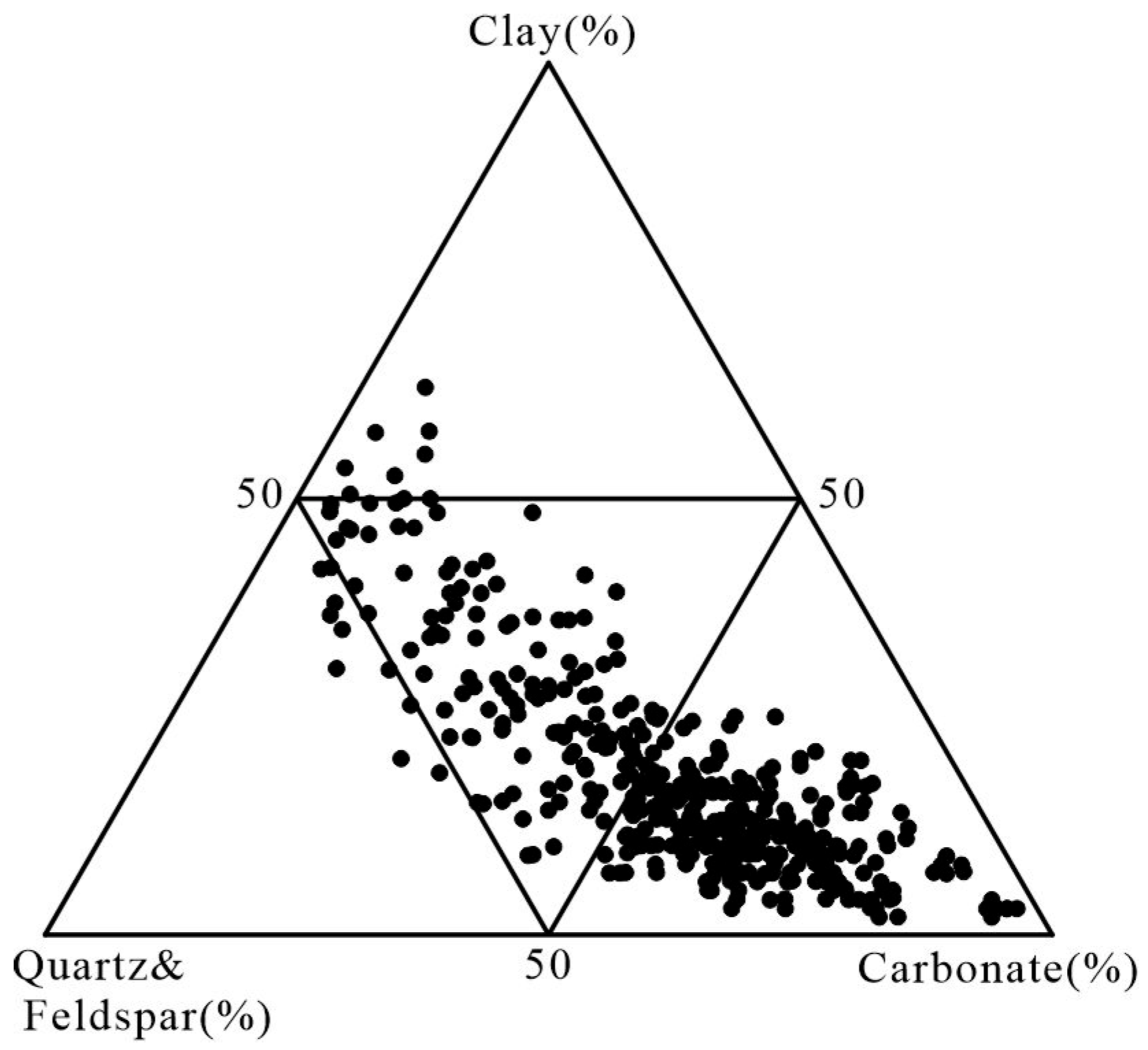

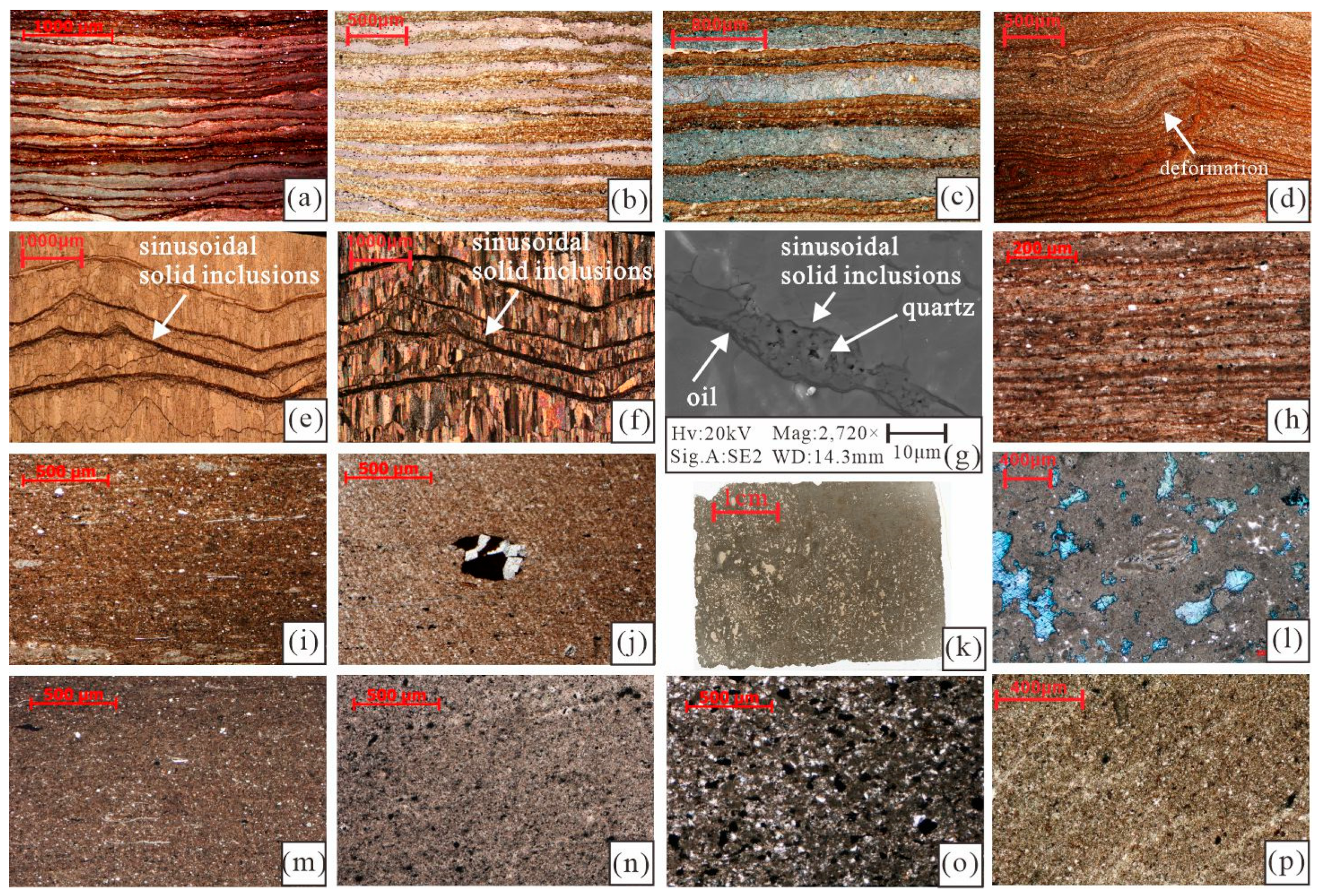
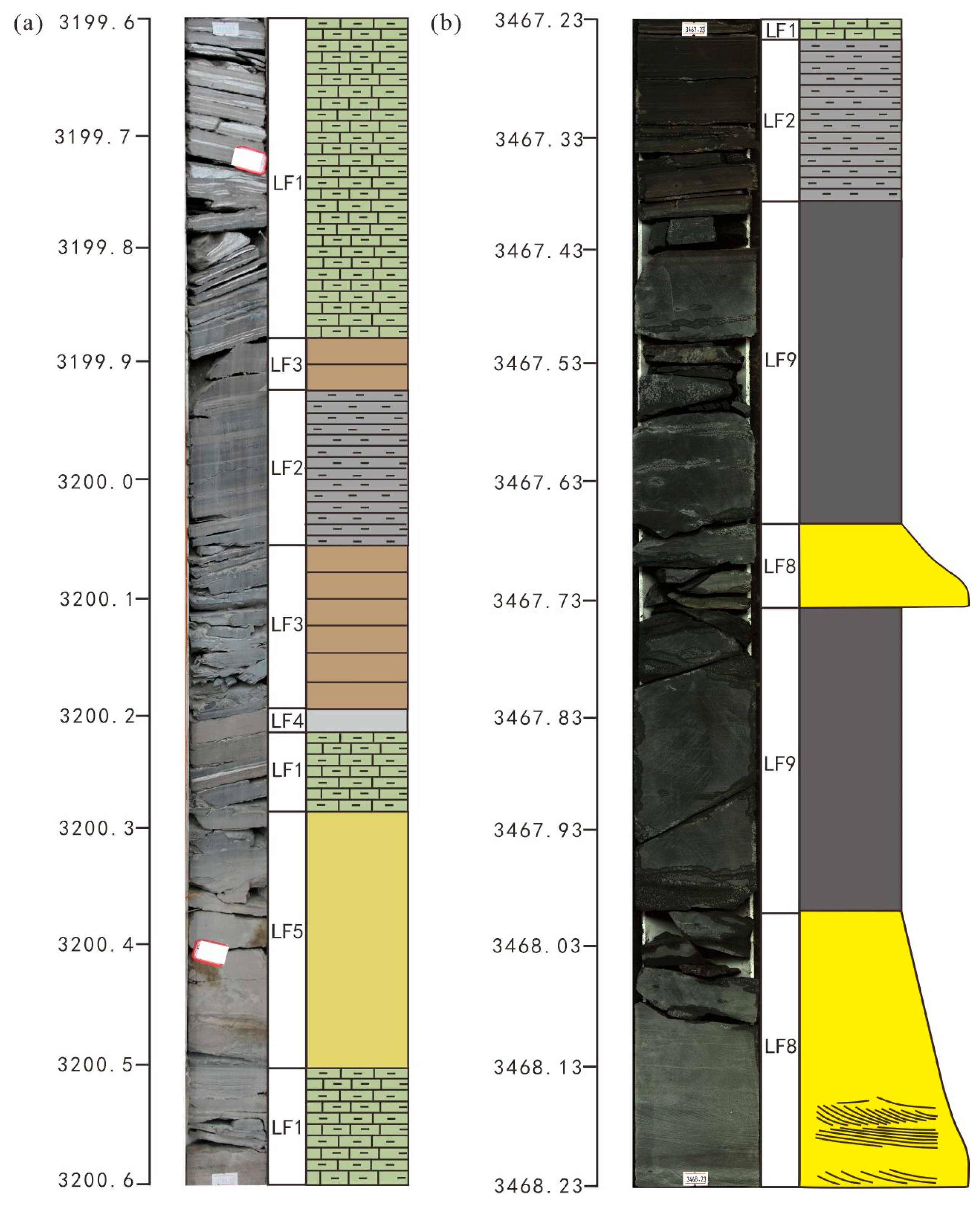
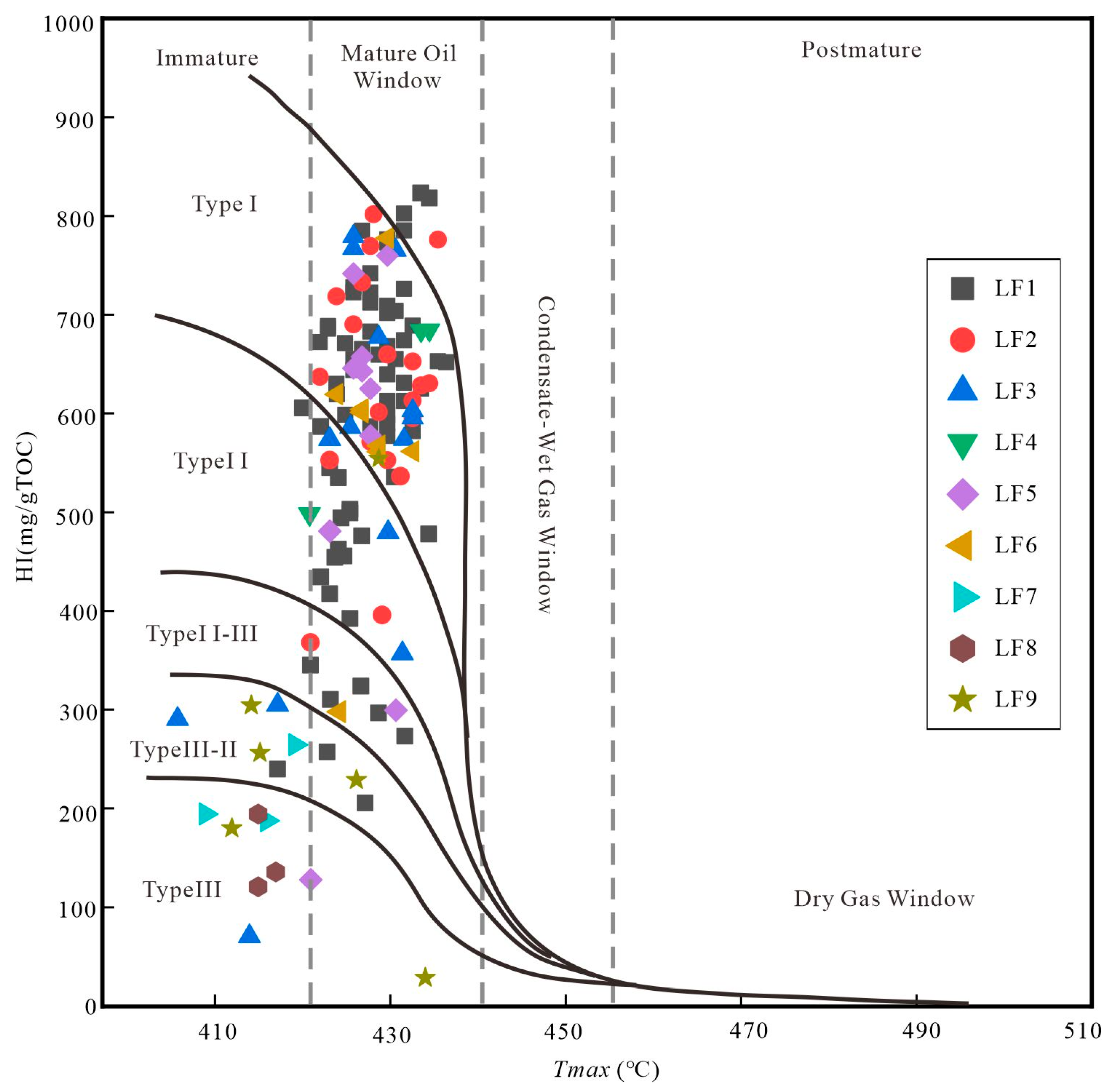
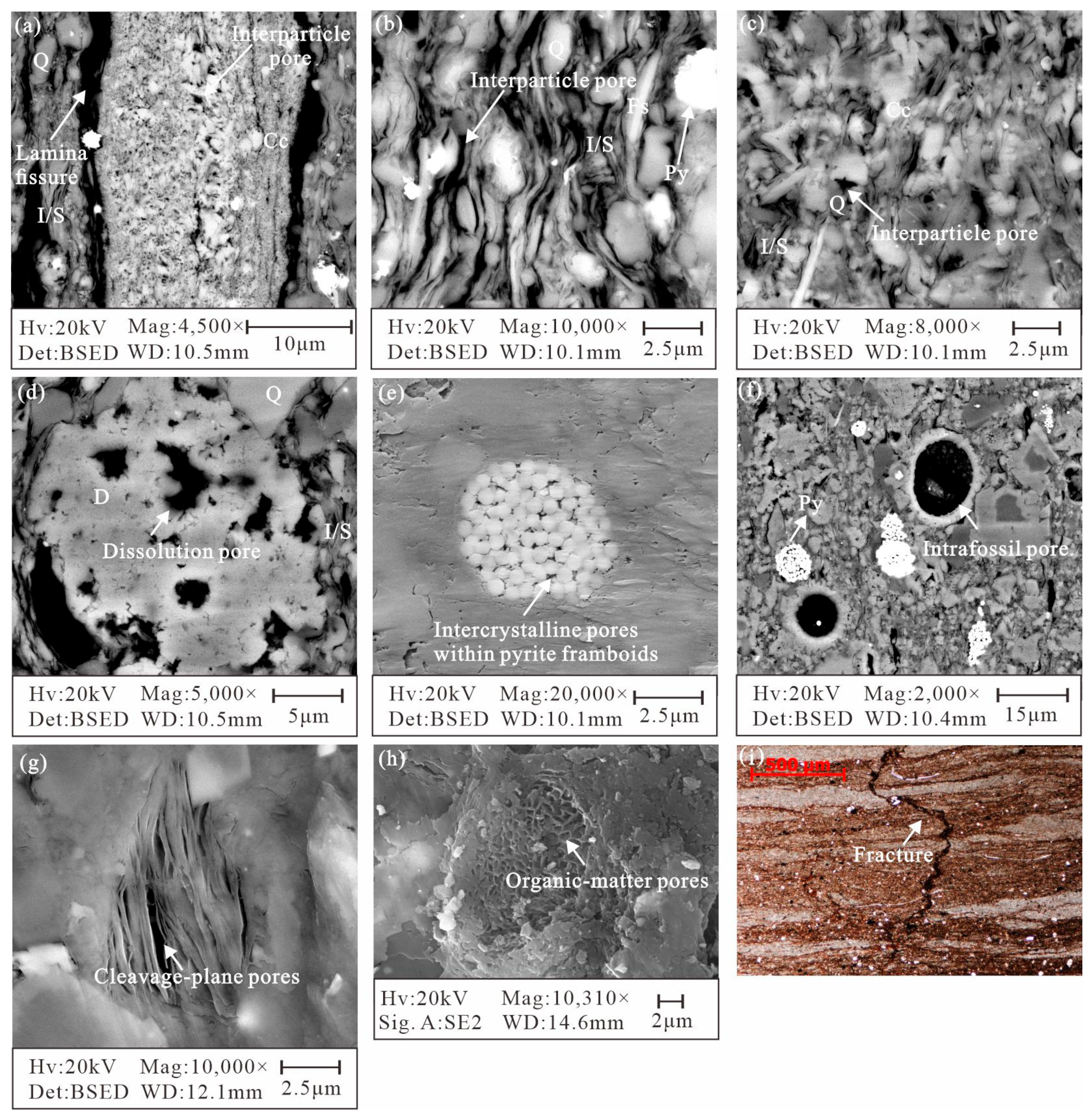

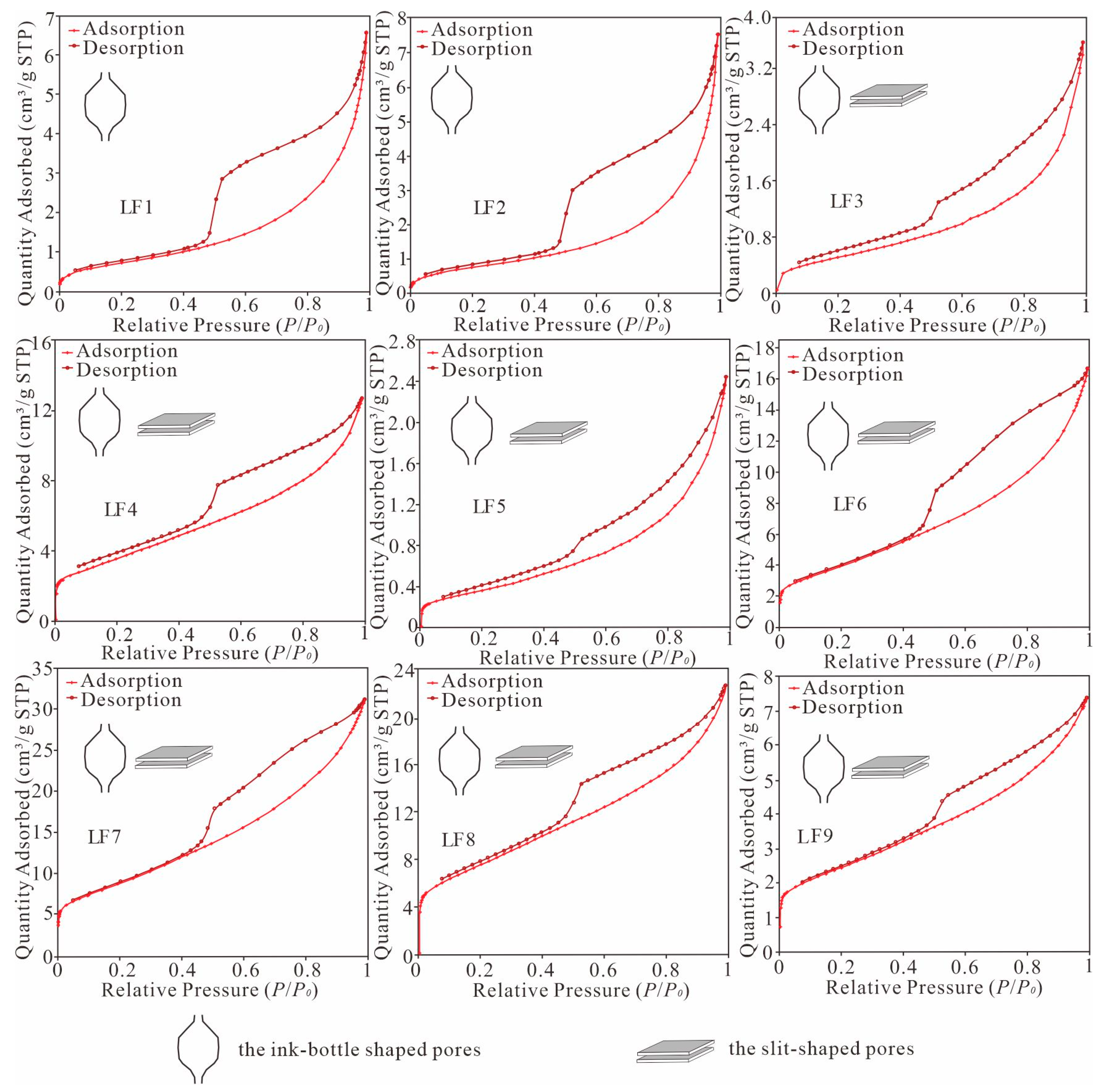
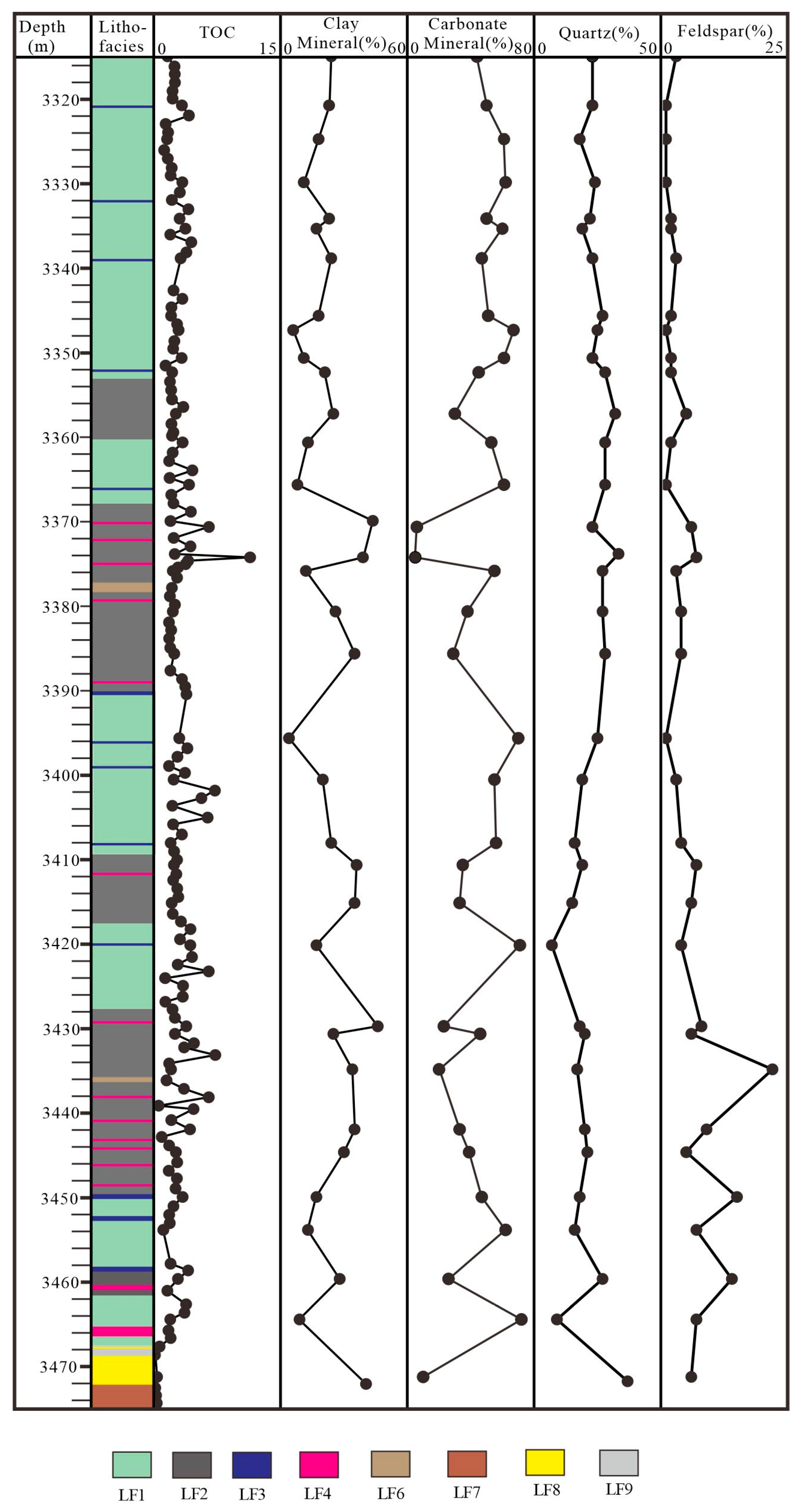
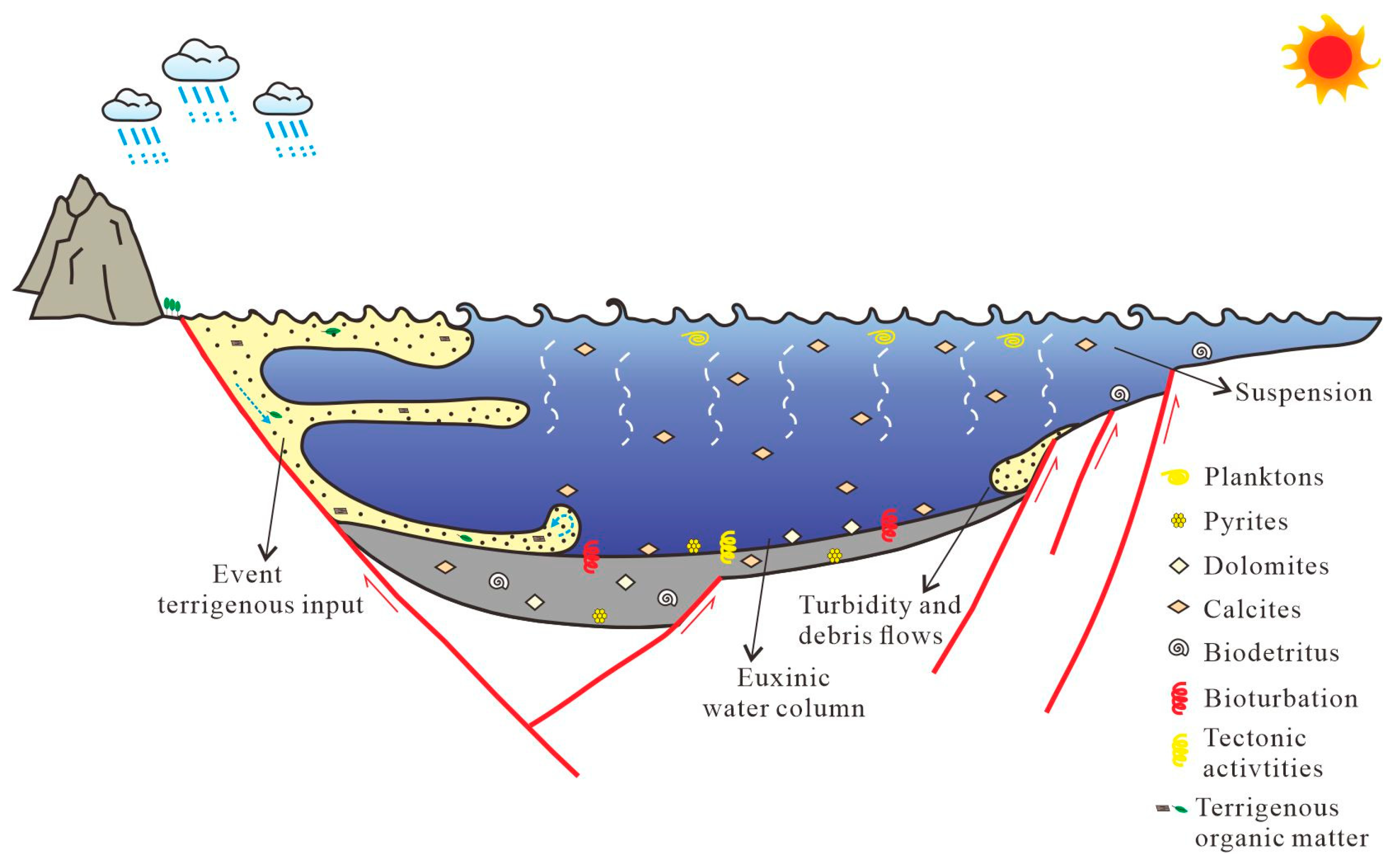
| Lithofacies | Clay Minerals | Quartz | Feldspar | Calcite | Dolomite | Pyrite | Anhydrite | Siderite | Halite | Aragonite | Barite | |
|---|---|---|---|---|---|---|---|---|---|---|---|---|
| LF1 | Average | 14.77 | 15.49 | 2.67 | 49.94 | 13.38 | 2.16 | 0.19 | 0.66 | 0.85 | 0.07 | 0 |
| Range | 4–24 | 3–28 | 0–7 | 6–85 | 0–78 | 0–5 | 0–1 | 0–3 | 0–2 | 0–4 | 0 | |
| LF2 | Average | 28.95 | 22.50 | 5.95 | 25.10 | 10.25 | 4.60 | 0.45 | 1.00 | 1.00 | 1.40 | 0 |
| Range | 17–37 | 15–41 | 2–15 | 11–47 | 0–28 | 1–10 | 0–1 | 0–2 | 0–1 | 0–13 | 0 | |
| LF3 | Average | 32.57 | 23.07 | 9.07 | 19.14 | 9.79 | 3.50 | 0.79 | 1.21 | 1.25 | 0 | 2.00 |
| Range | 25–43 | 17–32 | 4–22 | 8–35 | 3–28 | 2–8 | 0–2 | 0–2 | 0–2 | 0 | 0 | |
| LF4 | Average | 14.67 | 12.00 | 3.67 | 29.00 | 36.67 | 2.00 | 0.67 | 0.67 | 1.00 | 0 | 0 |
| Range | 11–17 | 7–17 | 3–4 | 11–59 | 4–54 | 1–3 | 0–1 | 0–1 | 0–1 | 0 | 0 | |
| LF5 | Average | 15.43 | 15.07 | 2.50 | 39.86 | 23.00 | 2.07 | 0.14 | 1.14 | 0.79 | 0 | 0 |
| Range | 6–23 | 7–22 | 1–5 | 0–62 | 0–79 | 0–6 | 0–1 | 0–2 | 0–2 | 0 | 0 | |
| LF6 | Average | 30.13 | 22.88 | 6.25 | 23.88 | 8.38 | 4.75 | 1.25 | 1.88 | 1.00 | 0 | 0 |
| Range | 21–39 | 18–26 | 4–11 | 10–38 | 3–21 | 3–10 | 0–4 | 1–4 | 0–1 | 0 | 0 | |
| LF7 | Average | 50.33 | 24.67 | 7.33 | 6.33 | 5.67 | 3.67 | 0.67 | 1.00 | 1.00 | 0 | 0 |
| Range | 47–52 | 22–28 | 6–9 | 5–8 | 5–9 | 2–5 | 0–2 | 0–2 | 0–1 | 0 | 0 | |
| LF8 | Average | 16.00 | 32.00 | 20.33 | 15.33 | 11.00 | 2.33 | 1.00 | 1.00 | 1.00 | 0 | 0 |
| Range | 13–19 | 29–34 | 19–21 | 13–17 | 6–15 | 2–3 | 1 | 1 | 1 | 0 | 0 | |
| LF9 | Average | 28.70 | 25.80 | 12.53 | 12.63 | 14.20 | 3.03 | 0.80 | 1.50 | 1.00 | 0 | 0 |
| Range | 24–41 | 13–27 | 3–11 | 0–39 | 4–36 | 2–5 | 0–1 | 1–3 | 1 | 0 | 0 |
Disclaimer/Publisher’s Note: The statements, opinions and data contained in all publications are solely those of the individual author(s) and contributor(s) and not of MDPI and/or the editor(s). MDPI and/or the editor(s) disclaim responsibility for any injury to people or property resulting from any ideas, methods, instructions or products referred to in the content. |
© 2023 by the authors. Licensee MDPI, Basel, Switzerland. This article is an open access article distributed under the terms and conditions of the Creative Commons Attribution (CC BY) license (https://creativecommons.org/licenses/by/4.0/).
Share and Cite
Yang, Y.; Jiang, Z.; Zhang, J.; Zhang, Z.; Yang, C. Control Effect of Deposition Processes on Shale Lithofacies and Reservoirs Characteristics in the Eocene Shahejie Formation (Es4s), Dongying Depression, China. Energies 2023, 16, 2200. https://doi.org/10.3390/en16052200
Yang Y, Jiang Z, Zhang J, Zhang Z, Yang C. Control Effect of Deposition Processes on Shale Lithofacies and Reservoirs Characteristics in the Eocene Shahejie Formation (Es4s), Dongying Depression, China. Energies. 2023; 16(5):2200. https://doi.org/10.3390/en16052200
Chicago/Turabian StyleYang, Yepeng, Zaixing Jiang, Jianguo Zhang, Zongxuan Zhang, and Chun Yang. 2023. "Control Effect of Deposition Processes on Shale Lithofacies and Reservoirs Characteristics in the Eocene Shahejie Formation (Es4s), Dongying Depression, China" Energies 16, no. 5: 2200. https://doi.org/10.3390/en16052200
APA StyleYang, Y., Jiang, Z., Zhang, J., Zhang, Z., & Yang, C. (2023). Control Effect of Deposition Processes on Shale Lithofacies and Reservoirs Characteristics in the Eocene Shahejie Formation (Es4s), Dongying Depression, China. Energies, 16(5), 2200. https://doi.org/10.3390/en16052200





